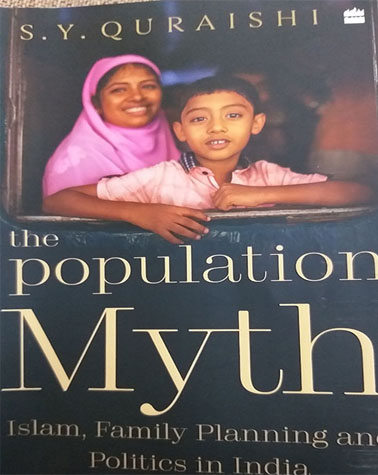
By Naz Asghar
Feb 25, 2021
New Delhi: Contrary to the much hyped claims about explosion of the Indian Muslims’ population, their fertility rate is falling in line with Hindu fertility rate, and gap between the growth rate of the population of the two communities was closing fast so there is no fear of them ever outnumbering the majority community, says former chief election commissioner of India S Y Quraishi.
However, there is a lack of effort from the government, scholars and NGOs to dispel the misconception that the numbers of the country’s largest minority community is multiplying by leaps and bounds, Quraishi said in an interview to India News Stream.
It is true that Muslims’ birth rate is highest, but it is also a fact that Hindus’ birth rate is second highest and there is difference of only one child between a Hindu family and a Muslim family, which means to say that if Muslim family has five children children, Hindus have four, therefore, they are not
very far behind, he argued.
So the myth that Muslims’ population is growing too fast is busted when examined in the light of hard data, which prompted him to investigate the matter to counter the false propaganda whose motive has been out and out political, to manufacture a conspiracy theory that Muslims by increasing their numbers want to capture political power, he said.
Answering various questions in the context of his latest book ‘The Population Myth: Islam, Family Planning and Politics in India’ which has has just hit the stands, the former chief election commissioner said that he has based his claims only on the basis of data supplied by the Government of India.
A fear is being created in the mind of the majority community that Muslims were going to outnumber them in the near future, the sole purpose of which is to polarize the two communities by creating hatred among them to reap electoral benefits, he said.
But going by the official statistics Muslims are never going to overtake Hindus, even 600 years later or even 100 years hence as has been proved by a mathematical model based on these statistics developed by former VC of Delhi university Dr Dinesh Singh, he said.
”The Hindu right wing is exhorting the majority community to produce a large number of children to avoid being outnumbered by Muslims, but I would still appeal to Muslims not to be provoked by this call, and take to family planning. We in India cannot afford a procreation war,” he said.
When asked whether there was acceptance of family planning among Muslims as there was a general perception that Islam was against the practice, Quraishi said that at present if Muslims are having lowest level of family planning ((45.3 per cent), Hindus too have the second lowest percentage of family planning among other communities.
But it was also a fact that Muslims had now started taking to family planning faster than Hindus despite many of them believing that Islam was against the concept of family planning, which is not the case going by the Quranic injunctions.
As interpreted by Islamic jurists, though sterilization is not favoured by Quran, other methods of family planning like spacing find support in the scripture. For example, the injunction for compulsory breast feeding of children for two years has been interpreted as a measure to ensure gap between births, in the interest of both mother and child. Dr Quraishi quoted various verses and citations from Hadeeth ( traditions of the Prophet) which lay stress on proper upbringing of children, which is possible when the number of children is small. These verses show that Islam prefers quality over quantity, he said.
He quoted one more verse from Quran (Surah Noor) which says, let those who find the wherewithal for marriage keep themselves chaste, until Allah gives them means out of his grace.
”This injunction from Quran, Quraishi says is clinching evidence of Islam preferring quality over quantity.
Replying to a question, he said that much is also made of provision of a man allowed to take more than one wife in Islam to create an impression that this practice was responsible for spurt in Muslim population, but the fact was that there is no injunction in Quran for polygamy, but only a conditional permission to marry orphans and widows on the condition that all wives are to be treated equal, and this permission has a historical context which is that in Arab countries in those days there were frequent tribal wars which left many women orphaned and widows.
And despite this permission of polygamy, in practice no Muslim in general goes for two wives. Practically it is not possible as sex ration in India is skewed (943 women per 1000 men- 2011 Census), so statistically, no Indian has even one full wife. Each has 0.9 of a wife. Polygamy in any case cannot lead to high birth rate as the number of polygamous men, however, few would result in many unmarried men (who would not find wives) .
Polygamy is not common in the minority community, and in fact a polygamous is looked down upon in the society, he said, adding that it was unfortunate that religious leaders were not prepared for any legislatitive reform in the matter.
” Narendra Modi, as chief minister of Gujarat in 2002 was quite off the mark when he mockingly remarked ‘ham panch hamare pachchis” , insinuating that every Muslim has four wives and 25 children,” Quraishi said.
Marriage in Islam is not just for producing children, he emphasized. In fact , Islam is the forerunner of the concept of family planning despite the fact that this religion appeared 1400 years ago when there was no population pressure in the world, he pointed out.
He also pointed out a few verses from Surah Ar Rehman:” And one of his signs is this: He created your mate from yourself that you might find tranquillity in them, and He ordained between you love and mercy.” Significantly, Quraishi said this verse neither mentions children nor procreation as purpose of marriage, it suggests tranquility is the overall purpose of marriage, which is more attainable since all couples can achieve tranquillity but not all couples are fertile.
The Islamic position on family planning at present coincides with the policy of the government of india which too lays stress on spacing in preference to sterilization, he said.
Replying to a question he said major Muslim countries in the world were pursuing an active family planning programme. ”You would be surprised to know that a conservative Muslim country like Iran has 72 per cent acceptance of family planning as compared to only 52 per cent in India.
The Muslim fertility rate in India is falling in line with Hindu fertility rate and the difference is narrowing. This would lead to convergence in fertility rate for all religious communities in the long run, resulting in population stabilization in every community as a whole.
Quoting the Sachar committee report, he said if the falling growth rate is taken into account the Muslim population will stabilize at between 17 per dent and 21 per cent of the total population by 2100, a far cry from the minority community ever becoming the majority in the country.
He emphasized that the high birth rate in Muslims so far and among all Indian communities was related to other factors which are non-religious, such as low levels of literacy, and access to health services.
In fact there was an unmet demand for family planning among Muslims as they catch up in educational and economic development, he said.
–India News Stream



















